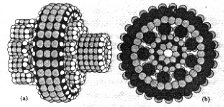Andromeda: People: Bots and Droids
There is a myriad of high tech gadgetry and special stuff onboard the Andromeda. These can be categorized as Robots, Nanobots and Drones.
Andromeda Robots
Multipurpose Shipboard Robots are wheely robotic units used for basic duties such as delivery and maintenance and cleaning toilets and things.
 The General Utility Androids are the closes thing to human sized Isaac Azimov robots we see on Andromeda. on the Andromeda TV website they are described as being similar in shape to the robots of Metropolis – they are certainly metallic, and they perform a wide variety of maintenance tasks including advising and helping crew members in the performance of their duties.
The General Utility Androids are the closes thing to human sized Isaac Azimov robots we see on Andromeda. on the Andromeda TV website they are described as being similar in shape to the robots of Metropolis – they are certainly metallic, and they perform a wide variety of maintenance tasks including advising and helping crew members in the performance of their duties.
If you were to meet a utility robot in the pub you would ask it, “why do you have breasts?“
Self-guided Recording Units (“Cambots”) are used to gather intelligence, surveillance information and other useful gossip for the ships main computers and command staff. They have anti gravity semi-sentient video, audio and smelling devices so that they can record stuff on and off ship.
Planetfall Defence

The Planetfall Defence (known as OEBots) have been affectionately nicknamed “Tweedle-Dee” and “Tweedle-Dum” by the crew. They are ground defence robots equipped with a monstrous array of weaponry. They are used only in the event of a full-scale pitched battle and can be deployed on land or in space.
Andromeda Nanobots

Andromeda Ascendant is crammed full of creepy crawly, little-hidden-things called Nanobots, and a massive array of other robotic gadgets to help keep things running ship-shape and Bristol fashion.
The most worrying Nanobots are the Intruder Control Nanobots (called IC’s) They are usually only used as a last resort, but when activated, they seek out intruders and attack their central nervous systems. They temporarily immobilize them until security can apprehend the intruders (or kill them).
The General Maintenance and Repair Nanobots (known as GMR’s) are used to keep the systems working in order. They concentrate primarily on repair after accidents or battles. Usually deployed in areas of the ship which are inaccessible to organic lifeforms, the GMR’s are an invaluable tool.
If you were to meet a Nanobot in the pub you could quite happily stand there chatting until the men in the white coats in the van with the square wheels came to take you away.
A really useful Nanobot is the Nuclear, Biological, Chemical Defense Nanobot (called NBC’s) They detect and disable all varieties of biological and radioactive attacks upon the ship and crew.
Mind you, they can’t have Nanobot’s without having anti-Nanobots. If the Andromeda can have such technology, then so can an aggressor. Therefore the Andromeda has a full complement (a few billion I guess) of Nanobot Inhibitors (NI’s) programmed to destroy hostile intruder Nanobots.
All this micro-atomic stuff may seem, at first sight, to be complete and utter bollocks! But it isn’t as far away from reality as you might think!
At some point for instance, we will all have our own food machine! Imagine going out into the garden and helping yourself to a plate of soil, leaves, treebark and rotting vegetable matter from the compost heap! Then you place the plate into an appliance that looks much like a microwave. You push a button and out comes a piping hot rump steaks with chips (French fries) and gravy!
 Ok, I know it sounds far fetched, but based on the thinking of people such as Nobel prize-winning scientist Richard Feynman and the remarkable Eric Drexler, such technology is only tens of years away and not hundreds as you might think.
Ok, I know it sounds far fetched, but based on the thinking of people such as Nobel prize-winning scientist Richard Feynman and the remarkable Eric Drexler, such technology is only tens of years away and not hundreds as you might think.
Fundamentally, the technology relies on a community of tiny programmable robots called assemblers, so small that they can work with individual molecules of matter. A group of these assemblers (called Nanobots by sci fi writers) could be programmed to produce any structure or entity allowed by the laws of nature.
Significantly, the limiting factor in this technology is it’s ability to change or create large structures quickly! If you imagine that you were able to have ten thousand million Nanobots all working for hundreds of years, they would still only manage to build an object the size of a tiny grain of sand! And as some of you scientists would agree, the kinetic energy of atoms is positively awe-inspiring! All atoms vibrate at certain temperatures, and what may seem (at macro-level) to be utter calm and stillness, would, in reality be the scene of the worst cosmic thrashing imaginable! Living at a molecular level would be like living in a boulder storm.
 Nevertheless, IBM managed to place 35 xenon atoms to form their logo, maybe this technology is not too far away.
Nevertheless, IBM managed to place 35 xenon atoms to form their logo, maybe this technology is not too far away.
When we consider the miraculous abilities of Andromeda’s Nanobot’s, maybe we should not dismiss this as fantasy, as the scientist Ralph Merkle once said, “Oh, fantasy, is that like going to the moon?”
Andromeda Drones
Andromeda also has over 20 types of drone device. These can be remotely controlled, or controlled by the crew, or even given some semi-sentient capability. They are used for maintenance, sensory activities (ie. they fly out from the ship short, medium and long distances), atmospheric surveillance (spy in the sky stuff) and a number of missile configurations.
The warfare capability of Andromeda is formidable and probably one of the most exciting aspects of the show. A great amount of thought has gone into the development of  ideas for space travel, warfare and robotics technology and the ship has been wonderfully designed by the chief writer Robert Hewitt Wolfe. The most exciting technology of the series, for me anyway, is the weaponry.
ideas for space travel, warfare and robotics technology and the ship has been wonderfully designed by the chief writer Robert Hewitt Wolfe. The most exciting technology of the series, for me anyway, is the weaponry.
It’s not only the ships computer that is sentient. Some of the drone weapons too can have a mind of their own. They simply need to be fired at a target and they intelligently pursue that target until they detonate. That is SOOO scary! Imagine being chased by a 100 megaton bomb that could, if it wanted to, chat to you about the latest football results or the hemline of the dress your wearing. Unfortunately it’s biggest goal in life is to blow you to smithereens.
“Why did she/he do that? I mean it’s not like I don’t love him/her or anything… I mean what would you do… eh… eh?” might be the conversation you would have with a drone if you were to meet one at the pub.
Wolfe on Andromeda-Tech
 The minor deity Mr Robert Hewitt Wolfe explains life, (or death) the universe and advanced laser beam weaponry (and everything):
The minor deity Mr Robert Hewitt Wolfe explains life, (or death) the universe and advanced laser beam weaponry (and everything):
“Space is really big (one of the first lines of Hitch Hikers Guide to the Galaxy – I wonder if it was a thinly veiled homage – I think it was, it could be considered a little patronising otherwise). If I have a laser beam and I want to shoot you and you are in space, my laser beam flies at the speed of light, which is a constant. They can’t go any faster than that. If I’m shooting at you and you are a reasonable distance away in space, say an A.U., which is 93 million miles, and I’m moving at a significant percentage of the speed of light, say 30 percent, and you’re moving at a significant percentage of the speed of light, I am never going to hit you in a million years with a laser beam.”
“If my beam is off by even a fraction of a percent I miss you by a thousand feet easy, so laser beams are not good unless you get really close. The best way to shoot at something in space is to shoot something smart enough that it will keep after it even if it moves. So those are drones, semi-sentient robots that say ‘I am a bomb – my purpose in life is to blow up.’ There are also fighters, which contain people, and people are really unpredictable. You can figure out what a computer might do because they work on algorithms, but it’s hard to predict what a person in a fighter will do. ”
“If the main thing that’s being shot at us are beams or objects wich are fired from up close, then what’s the best way to defend against that? Moving is really good, and most of our ships move at approximately 40 percent of the speed of light when they’re not moving faster than light. In order to achieve this, they have accelerations on the order of 50,000 Gs. You would turn to jelly very fast. If you want to compare the Andromeda to any current vessel it would be like a missile cruiser. It has a huge number of drones and a huge number of anti-drones that it can fire.”
The show’s approach to faster-than-light travel is equally interesting:
“There’s a speed limit in normal space, which is 186,000 miles per second, in order to go FTL you have to get away from a gravity well where space is as flat as possible. Then we take our anti-gravity projector and create an enormous gravity well, which opens up a rift in space, and we go into a place called slipstream, which is like string theory where everything is connected to everything else, and the bigger objects are the more strings they have connecting each other. We go into a place where these strings are somewhat visible, and we connect to these strings and go on a big roller coaster ride. ”
“The trick is that the strings are constantly changing and you have to decide constantly where you are going. It’s like interstellar surfing in that it’s much more like an art than a science, and the more in touch with your instincts you are the better you are at it.”
Very well put don’t you think?
The character/tech reviews are © 1999, 2001 Tony Fawl.
Not for reproduction without the authors express permission
The names, characters and everything else associated with Gene Roddenberry’s Andromeda TV series are the property of the Tribune Entertainment Company. All rights reserved.
Checkout their website
